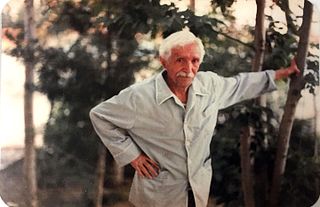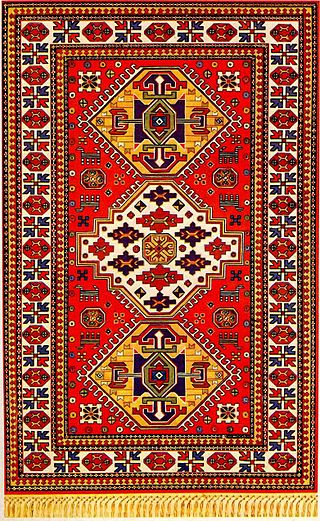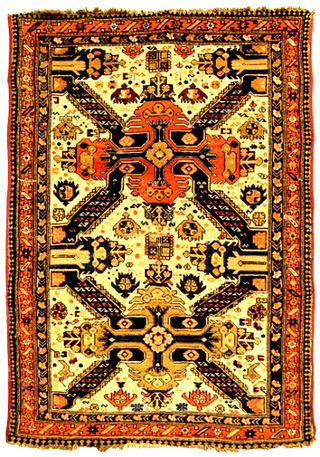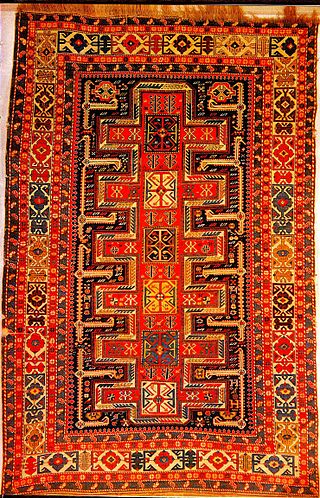
A Persian carpet or Persian rug, also known as Iranian carpet, is a heavy textile made for a wide variety of utilitarian and symbolic purposes and produced in Iran, for home use, local sale, and export. Carpet weaving is an essential part of Persian culture and Iranian art. Within the group of Oriental rugs produced by the countries of the "rug belt", the Persian carpet stands out by the variety and elaborateness of its manifold designs.

A Tabriz rug or carpet is a type in the general category of Persian carpets from the city of Tabriz, the capital city of East Azerbaijan province in northwest of Iran. It is one of the oldest rug weaving centers and makes a huge diversity of types of carpets. The range starts at Bazaar quality of 24 raj and on up to the incredibly fine 110 raj. Raj is the unit of knot density. It shows the rigidity of the rug which based on the number of strings used for the foundation of the rug. Strings materials are usually made of cotton or silk which is used for very fine rugs.
An oriental rug is a heavy textile made for a wide variety of utilitarian and symbolic purposes and produced in "Oriental countries" for home use, local sale, and export.

Ardabil rugs originate from Ardabil located in the province of Ardabil Province in northwestern Iran, 639 kilometers from Tehran. Ardabil has a long and illustrious history of Persian carpet weaving.

Azerbaijani carpet is a traditional carpet (rug) made in Azerbaijan. The Azerbaijani carpet is a handmade textile of various sizes, with a dense texture and a pile or pile-less surface, whose patterns are characteristic of Azerbaijan's many carpet-making regions. Traditionally, the carpets were used in Azerbaijan to cover floors, decorate interior walls, sofas, chairs, beds and tables.
Azerbaijani art is the art created by Azerbaijanis, other people that currently live on the territory of Azerbaijan, or people that used to live on the territory of Azerbaijan. They have created rich and distinctive art, a major part of which is applied art items. This form of art rooted in antiquity, is represented by a wide range of handicrafts, such as chasing (metalworking), jewellery-making, engraving, carving wood, stone and bone, carpet-making, lacing, pattern weaving and printing, and knitting and embroidery. Each of these decorative arts is evidence of the culture and the abilities of the Azerbaijan nation, and are very popular there. Many interesting facts pertaining to the development of arts and crafts in Azerbaijan were reported by merchants, travellers and diplomats who visited these places at different times.

Azerbaijan National Carpet Museum is a museum located in Baku that displays Azerbaijani carpets and rugs with historical and modern weaving techniques and materials. It has the largest collection of Azerbaijani carpets in the world. First opened on Neftchiler Avenue in 1967, it moved to a new building on the Baku's seafront park in 2014.

The boteh, is an almond or pine cone-shaped motif in ornament with a sharp-curved upper end. Though of Persian origin, it is very common and called buta in India, Azerbaijan, Turkey and other countries of the Near East. Via Kashmir shawls it spread to Europe at least in 19th century, where patterns using it are known since 1960s as paisleys, as Paisley, Renfrewshire in Scotland was a major centre making them.

Habib Saher, was an Azerbaijani poet, writer, translator and literary researcher. The founder of Turkish free poetry in Iran.

"Shabalyt buta" - Azerbaijani pile carpets part of the Karabakh group of the Karabakh type. The "Shabalyt buta" carpets belong to the complex composition of the Karabakh carpets. The main centres of production of the "Shabalyt buta" carpets were Jabrayil, Aghdam and Mugan. In an earlier period, carpets of the same pattern were woven at carpet weaving points located in the Iranian Azerbaijan, but they were rougher than the Karabakh ones. The silk carpets “Shabalyt buta” woven in Jabrayil were very popular.

Shedde, are Azerbaijani lint-free carpets. these carpets were produced mainly in Nakhchivan,Aghjabedi, Aghdam, Gubadly and Jabrayil.

"Bakhshayish" - Northwest Persian carpets belonging to the Tabriz type. They got their name from the village Bakhshayish, located 70 kilometres northeast of Tabriz. Until the recent past, this village was the centre of the household items of carpet manufacture production, including chuval, blankets, chuval, dzhurab, as well as lint-free kilim and palas carpets.

Borchaly describes a sub-category within the Gazakh group of Azerbaijani carpets, even though the region from which they originate is now within Georgia. The name of this carpet is associated with the name of the Borchaly region, located to in southeastern Georgia close to the border of Gazakh district, Azerbaijan. Large villages of this region including Gurdlar, Akhurly, Kachagan, Sadakhly (Sashikhly), Dashtepe and Lembeli were once famous for carpet weaving, though in recent decades the art of carpet weaving has almost entirely died out, leaving only two known villages where Borchaly style carpets are still woven: Kosalar and Mughanlo. The population of Borchaly including the above-mentioned villages consists mainly of ethnic Azerbaijanis.
The Absheron Carpet Weaving School is one of the Azerbaijani carpet weaving schools. The school covers the Absheron villages: Goradil, Novkhani, Surakhani, Nardaran, Bulbul, Fatmai, Mardakan, Qala, Khila, as well as the Khyzy region. Such centers of carpet weaving as Gadi, Khil, Kesh, Fyndygan and others are also known.

Demirchilar - Azerbaijani carpets belonging to the Gazakh group of the Ganja-Gazakh type. The name of this carpet is associated with the name of the village of Demirchilar near Gazakh in Azerbaijan. This carpet is also produced in the villages of Dash Salakhli, Kosalar, and Urkmazli from the Gazakh district. Demirchilar carpets are considered to be of the highest category carpets in the Gazakh group.

"Khila-Afshan" - pile carpets belonging to the Baku group of Absheron carpet weaving school.

Gollu-chichi or Gollu carpets — Azerbaijani carpets belonging to the Guba school of carpet weaving.

Gadim Minare carpets — Azerbaijani carpets belonging to the Guba carpet-weaving school.
Hamid Mammadzadeh – Azerbaijani writer, literary critic.
















